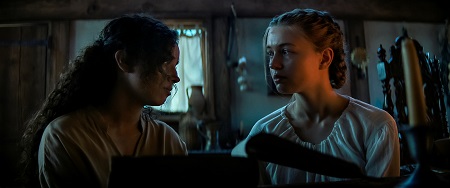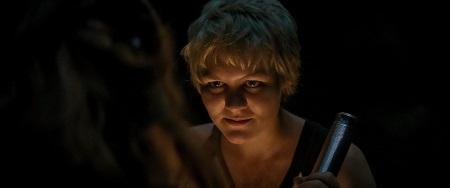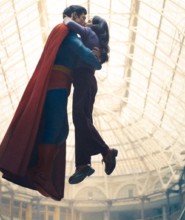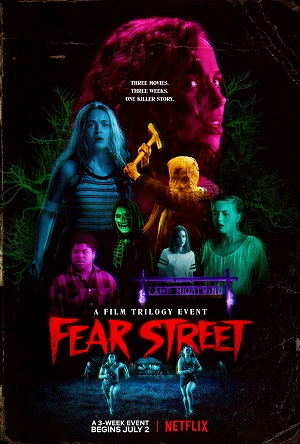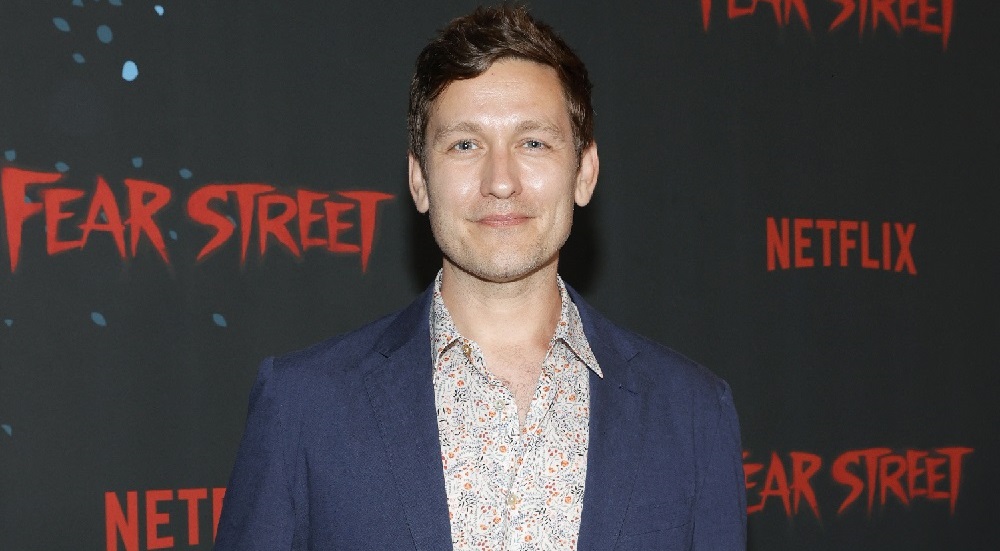
“Fear Street” – Interview with Phil Graziadei
by Sara Michelle Fetters - July 16th, 2021 - Interviews
A Walk Down Fear Street with Writer Phil Graziadei
With today’s release of Fear Street Part 3: 1666, Netflix’s horror trilogy inspired by the long-running series of books written by Goosebumps author R.L. Stine comes to a thrilling conclusion. Heroine Deena Johnson (Kiana Madeira), transported into the past to inhabit the body of supposed witch Sarah Fier, will discover the chilling origins of the terrifying curse that has affected the residents of Shadyside for almost three centuries.
Screenwriter Phil Graziadei has been a filmmaking partner of director Leigh Janiak for quite some time. The pair’s 2014 debut Honeymoon is a minimalist body-horror tale of love and death that puts its two main characters first and allows all of the insidious thrills and chills to be born directly from their relationship. It’s marvelous and worth the effort to seek out.
With Fear Street, the pair get to work their magic on a far bigger canvass. Throughout their ambitious trilogy, they, along with co-writers Kate Trefry, Kyle Killen and Zak Olkewicz, craft a sprawling tale of systemic oppression, patriarchal abuse and economic disparity as told through the eyes of a group of terrified yet strong-willed youngsters willing to make the ultimate sacrifice to change things for the better.
Most of all, they have crafted an epic love story between two teenage girls, Deena and Sam Fraser (Olivia Scott Welch); their complex relationship is the beating heart and soul that continually propels this trilogy forward. It’s a tale of outsiders and rebels finding the strength to do the right thing, with the survivors discovering that the truth behind an unimaginable evil is nothing like the creepy folk tales and urban legends residents of Shadyside have been whispering to one another for nearly 300 years.
I recently had the chance to sit down and chat with Graziadei about the Fear Street trilogy. Here are some edited excerpts from what he had to say:
Sara Michelle Fetters: Honeymoon was such a revelation to me. I didn’t expect to love it as much going in as I eventually did. But it’s very much a low-budget, very down and dirty, thought-provoking indie horror film. How do you and Leigh go from that film to being given the keys to the R.L. Stine kingdom and getting to make this wildly ambitious three-part trilogy?
Phil Graziadei: I think you just take the keys and gleefully say thank-you. For me, one of the things that’s appealing about horror is that you’re able to tell stories that deal with important issues through the kinds of metaphors that aren’t really accepted in other genres. For Honeymoon, obviously, that issue was scaled way down to something incredibly intimate between two people. For Fear Street, we could broaden our scope a little bit.
SMF: As part of broadening that scope, there are so many of Stine’s books in this series, there isn’t one through-line, if you will, other than they take place in the same location. You guys kind of got to have your cake and eat it, too, right? You had this world, but you were allowed to make it your own.
PG: We really were. The books, there’s so much in [them] for so many people, right? They’re so sprawling. Every element of teenage suburban life, you can find it in there somewhere.
But they also focus on the pleasures of gore, the brutality of it all. I think Stine himself is on record saying he never tried to tie it all together. I think it would have limited his options in a way.
I just was talking about this, and I wish I had the number on the top of my head, but there are so many of these books. Yet there are only a handful, I think three, that deal specifically with the history of Shadyside and how it got to be the way it is. But even within those books, they sort of reinvent their mythology as they go through.
We definitely took a different approach. We knew we had this closed trilogy. We wanted to be able to close the chapter at the end of each movie, yet also have a satisfying conclusion for our characters from the ‘90s once the third movie was finished. That was the challenge.
SMF: Talking about those characters from the 1990s, while I am no R.L. Stine expert, at least in the Fear Street books that I have read, I don’t think other than some mild homoerotic subtext that you have characters in those books who are anything like Deena or Sam.
PG: No, there aren’t. But those books do some incredible stuff for their time period. They do take to task, for instance, the way women are presented in horror. There’s good stuff in there. So, I want to be clear when I’m saying this, like with any popular culture, they’re a product of their time. Stine was marketing them toward teenagers. I think for me and Leigh, we wanted the movies to be a product of this time. I mean, obviously, I’m personally invested in Queer representation, but that was something we both wanted to tackle.
SMF: Here’s the great thing about these characters. You have constructed an entire trilogy revolving around the complex and not always heartwarming relationship between two teenage girls, and yet we want to see them survive this terror throughout the entire thing. How hard was that to do? To construct authentic characters and plant them in this outlandish supernatural maelstrom?
PG: That’s a great question. How hard was it to do? I think for us, their relationship is the emotional core of the trilogy. It’s such a big world to make sense of. Obviously, though, their love story is the core of the story. For me, considering the long history of horror and the way that Queer people are traditionally represented, you’re either a tragic victim of society or the monster and, if you’re really lucky, a combination of those two things. Sometimes even a sympathetic monster in the vein of Frankenstein.
I think for me, it was important to take sort of those Queer issues out of the subtext that allowed them to be presented as intrinsically monstrous and to foreground this into the story. In a hundred years of horror movies, no one has built a story around a Queer relationship that survives, right? Certainly not in any sort of mainstream movie.
With Fear Street, it’s addressing the role of Queer people as an important part of society just in general? For so much of our lives as Queer people, we have been relegated to having to dig through the subtext of a story for reflections of ourselves in the biggest sorts of mainstream popular culture and media. I didn’t want to have to do that here.
SMF: I think what you are talking about here is very specific to these characters who populate this trilogy. You populate all three of the films with a lot of outsiders. You don’t judge them. You let them just be.
A prime example is Alice in 1978. They are such a great character. They could easily be the main character in a Sleepaway Camp entry in another world. A true misunderstood villain. Yet here you give them this incredible hero arc — I see you’re smiling, so I think you know where this is going — that I didn’t see coming.
When you were dealing with all of these characters, not just Alice, was this always part of the plan, for each to have a challenging, often redemptive arc that maybe the audience wouldn’t anticipate?
PG: I always feel so stupid saying this kind of shit about my own work, but the characters for us are the most important thing about each movie. If you don’t care about them when they die, well, what’s the point of killing them? I think why I’m smiling when you’re talking so much about Alice is because, aside from the fact that we foregrounded Queer characters as sort of the emotional core and centerpiece of the story, there’s also a lot of coding in these movies. We didn’t take it all away. I love it when people read into these things. It’s really gratifying. I don’t want to say much more.
SMF: Fair enough.
PG: It’s like you said earlier, you can very much have your cake and eat it, too.
SMF: Let’s talk about the tonal shifts. 1994 is definitely in sort of the more Scream, late ’90s, early aughts horror vein. You’ve got the humor. You’ve got the gore. You’ve got everything going on. 1978 is a definite shift. Yes, there are some funny bits, but this is very much a Friday the 13th meets Sleepaway Camp meets kind of The Burning sort of thing. It’s a lot more serious. Then with 1666, I felt like you were suddenly in Hammer territory. I kept waiting for Christopher Lee to show up.
By the very nature of a trilogy like this, you had to engage with these tonal shifts just to keep people interested. At the same time, there is the chance that people who are blown away by watching 1994 are going to walk into 1978 and be like, wait, what’s happening? Were you ever worried that you were almost being too ambitious by shifting gears so significantly between each film?
PG: I mean, it didn’t occur to me until just now. [laughs]
You’re spot-on in saying that we knew we had this quick release schedule. That was always the intent. Part of being able to sell this idea to the studio was explaining how you were going to make audiences come back and watch a sequel or another piece of the same franchise in such quick succession. One of those answers is by giving them something completely different. If they’re all unified around the same story and theme, though, then you’re getting different pieces of the mythology and the history unfolding in there at the same time. I think we were pretty confident that we could hold it all together.
Also, having that variation from movie to movie was a huge part of the appeal. We got to play around. We got to completely shift gears between each installment.
SMF: But did you ever feel like your hands were a little tied from a storytelling aspect? With 1994 and 1666, there is this feeling that permeates each installment that anything can happen. With 1978, while there are some great twists and reveals, I did feel like there weren’t as many opportunities to genuinely surprise, I felt like that your hands were kind of tied, maybe just a little bit. Did you ever feel that way?
PG: I don’t think so. Honestly, the first part of the story, of the entire trilogy that we had cemented was 1666. Even though we’re giving you everything backward, we created it chronologically. I felt like we certainly explore fewer new elements of the mythology in 1978. But I also think that that’s great for the movie, too. It lets people breathe for a minute and sort of relish in the slasheriness of it, which is all part of the fun.
SMF: What I do love about 1978 is that normally, especially with middle films in a trilogy, the cliffhanger can sometimes feel annoying. The film doesn’t feel as self-contained, because it needs to get you to the next feature. I didn’t feel that with 1978, and the cliffhanger itself was awesome. I felt like you’d told a self-contained story, so I didn’t get upset that I needed to still see more, if that makes sense.
PG: Exactly what we were going for.
SMF: I mean, as much as I admire and respect the filmmaking craft of Back to the Future Part II, I can’t really watch it, because I feel like it’s not its own movie. But I could watch 1978 on repeat and never grow tired, even though it ends in a way we can’t really go into detail here.
PG: That’s a great review, as far as I’m concerned.
The films sort of toe this line between features and long-form television. So as much as I say that we wanted to close the chapter completely, you do really need to watch them all together to make sense of it all.
We want people to feel as satisfied as possible with each movie on its own. We didn’t want to feel like we were cheating people or trying to string them along. A thing that was helpful was to try to approach them from the characters’ perspectives at all times. We made sure that everything you learn about the history of Shadyside and what’s happening is tied to their perspectives, aside from a couple moments of foreshadowing or dramatic irony.
I think that helps. It helps people to experience this story along with the characters. It’s also why you care when they go through the bread slicer or whatever.
SMF: You know that moment is going to become like one of the biggest GIFs on the internet at some point, right?
PG: I’m for it. I’m all for it. [laughs]
SMF: This does lead me to something that I mentioned to a few people and in my review of 1994. It’s like with the bread slicer, it kills me that I was not watching that moment with a packed house in a theater. At the same time, I’m honest enough to realize that I don’t believe this trilogy exists in this form without Netflix. You made an unabashedly Queer horror trilogy that people are loving that wouldn’t exist if it didn’t have Netflix footing the bill.
Do you have any thoughts on that? I think we all want people to enjoy these films together, and there is sort of a communal aspect thanks to social media. But it isn’t quite the same, is it?
PG: Netflix has been incredible. From the second they had the chance to acquire these they’ve been so supportive and great, which is a big deal.
But, yeah, I think any filmmaker sort of laments the sort of decline of the communal experience at the movie theater. But I also hope that people don’t feel like they have to watch everything on Netflix by themselves. I’ve gotten groups of friends together to screen these movies. It’s wonderful. I think people can do that with Netflix, too.
But you are right. Horror movies, there’s something that’s really fun about being in a theater with at least a few people who are maybe a little too demonstrative in their responses to what’s going on. That’s always a blast. It is sad to miss out on that.
But Netflix is a perfect home for these, and I hope people watch them together.
SMF: When you get to 1666, everything comes full circle in a profound way. You end up talking about the patriarchal foundation of America in some very surprising ways that, especially for young viewers, I feel could be important. Yet, it’s also still gory and silly and fun and nasty and has great character moments and some wonderful reveals. But it still seemed clear to me that you all are making some profound statements in a not-so-subtle way. Am I reading too much into that?
PG: From the very beginning we conceived of the project as a sort of an allegory of systemic oppression. I think that’s clear, and some of the ways that come across, obviously, you’ve picked up on. It’s there in the intertextuality between the films and the sort of cyclical natures of this violence that we get to revisit through the eyes of certain characters later on in the series. It’s all deliberately structured.
I don’t want to ruin it for people. But, yeah, that was our approach from the beginning. We wanted to tell this story about outsiders struggling in this system that feels like it’s stacked against them, where the things that make them outsiders are ultimately the things that allow them to fix their problems in that world.
SMF: For you personally, what has this experience meant to you? What do you hope you take from it moving forward?
PG: This should be an easy part, talking about me instead of the work. [laughs]
Nothing could make me happier than being able to bring these Queer stories in a mainstream format to audiences all over the world at the same time because of Netflix’s distribution model. It’s so important.
It’s so important that people see these stories, see Queer people who have a possibility for happiness in their lives, who aren’t just victims or villains or monsters. In general, people have been really supportive of that. I think one of the things that’s happened for me since these movies have started to come out is that I’ve had so many kids reaching out to me on social media, talking about how they’ve never felt like they’ve seen themselves presented on screen before.
It’s incredible. I don’t think any writer could hope for anything more than that. I hope that Hollywood will take a page out of Netflix’s book and take more of these kinds of risks of telling stories for broad audiences that center Queer characters. I’ll never get tired of hearing stories about kids who watch these movies and feel like they’re less alone.
– This interview reprinted courtesy of the SGN in Seattle
